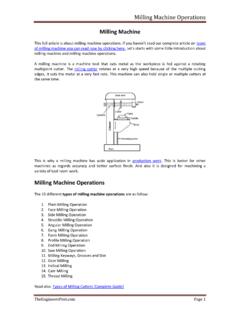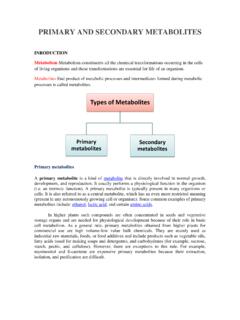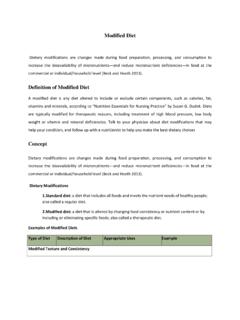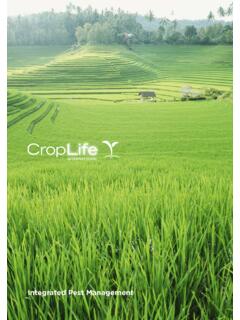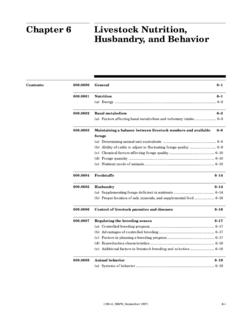Transcription of Seed and seed technology: introduction, definition and ...
1 PRINCIPLESOF seed TECHNOLOGYDr. Rudrasen Singh RaikwarAssistant ProfessorCollege of Agriculture TikamgarhSeed and seed technology : introduction , definition and importanceIntroductionThe history of agricultural progress from the early days of man has been the history of seeds ofnew crops and crop varieties brought under cultivation. In the early days it was achieved throughthe cultivation of indigenous but useful plants and those taken through introductions. Laterthrough the well known techniques of selection, hybridization, mutation, polyploidization andplant biotechnology the scientists made available many new and better varieties. However, to thefarmer all this scientific research would be of little value unless he gets seeds, which aregenetically pure, high germination percentage and vigour, high purity, sound health etc.
2 , Whenthe farmers do not get seeds possessing these qualities the yields they obtain may not be asexpected. The pace of progress in production therefore, will largely depend upon the speed withwhich we are able to multiply and market good quality seeds of high yielding of seed TechnologyCowan (1973) identified seed technology as that discipline of study having to do with seedproduction, maintenance, quality and preservation .Feistritzer (1975) defined seed technology as the methods through which the genetic andphysical characteristics of seeds could be improved. It involves such activities as varietydevelopment, evaluation and release, seed production, processing, storage and seed technology is essentially an inter disciplinary science which encompasses broad rangeof subjects.
3 In its broadest sense, seed technology includes the development of superior cropplant varieties, their evaluation and release, seed production, seed processing, seed storage, seedtesting, seed certification, seed quality control, seedmarketing and distribution and research onseed physiology, seed production and seed handling based upon modern botanical andagricultural sciences .In a narrow sense seed technology comprises techniques of seed production, seed processing, seed storage, seed testing and certification, seed marketing and distribution and the relatedresearch on these aspects .Concept of seed technologyThe distinction between seed and grain is vital, being of seminal importance to agriculture. Aseed, strictly speaking, is an embryo a living organism embedded in the supporting or the foodstorage tissue.
4 The seed pertains to material ( seed , fruit or vegetatively propagating material)meant for saving for planting purposes, the essential function being the reproduction. The seedwhen scientifically produced (such as under seed certification) is distinctly superior in terms ofseed quality, namely, the improved variety, varietal purity, freedom from admixtures of weedsand other crop seeds, seed health, high germination and vigour, seed treatment and safe moisturecontent etc. A grain on the other hand, includes cereals and pulses meant for between scientifically produced seed and the grain (used as seed )S. NoSeed (Scientifically produced)Grain (used as seed )1It is the result of well planned seedprogrammeIt is the part of commercial produce savedfor sowing or planting purposes2It is the result of sound scientificknowledge, organized effort,investment on processing, storage andmarketing such knowledge or effort is required3 The pedigree of the seed is ensured.
5 Itcan be related to the initial breedersseedIts varietal purity is unknown4 During production, effort is made torogue out off-types, diseased plants ,objectionable weeds and other cropplants at appropriate stages of cropgrowth which ensures satisfactoryseed purity and such effortis made. Hence, the purityand health status may be inferior5 The seed is scientifically processed,treated and packed and labeled withproper lot grain used as seed may be manuallycleaned. In some cases, prior to sowing itmay also be treated. This is not labeled6 The seed is tested for planting qualitynamely, germination, purity,admixture of weed seeds and othercrop seeds, seed health and seedmoisture seed testing is not done7 The seed quality is usually supervisedby an agency not related withproduction ( seed certification agency)There is no quality seed has to essentially meet the quality standards.
6 The quality istherefore well known. The labels,certification tags on the seedcontainersserves as quality such standards apply here. The quality isnon-descript and not of seed technology :Feistritzer (1975) outlined the following roles of improved Improved seed a carrier of new technologies The introduction of quality seeds of newvarieties wisely combined with other inputs significantly increase yield levels. In India, thecultivation of high yielding varieties have helped to increase food production from 52 milliontonnes to nearly 180 million tonnes over a period of 40 Improved seed a basic tool for secured food successful implementation of the high yielding varieties programme in India has led to aremarkable increase in production and food imports from other counters have been brought downinspite of rapid increase in Improved seed the principal means to secure crop yields in less favorable areas ofproduction.
7 The supply of god quality seeds of improved varieties suitable to these areas is oneof the important contribution to secure higher crop Improved seed a medium for rapid rehabilation of agriculture in cases of natural disaster. Incase of floods and drought affected areas the Govt. will provide the improved seeds fromnational seed stocks to rehabilate the agricultural production of foods grains in the countryGoals of seed technology :The major goal of seed technology is to increase agricultural production through the spread ofgood quality seeds of high yielding varieties. It aims at the multiplication: Increase in agricultural production through quickest possible spread ofnew varieties developed by the plant breeders. The time taken to make available the desiredquantities of seeds of improved varieties to farmers should be considered as a measure ofefficiency and adequacy in the development of seed technology in the supply: The improved seeds of new varieties must be made available well in time, sothat the planting schedule of farmer is not disturbed and they are able to use good seed forplanting purposes.
8 3. Assured high quality of seeds: This is necessary to obtain the expecteddividends from the use of seeds of improved varieties. 4. Reasonable cost of high quality seed should be with in reach of the average causes of crop varieties and their control;Variety: Is a group of plants having clear distinguished characters which when reproduced eithersexually or asexually retains these main aim of seed production is to produce genetically pure and good quality seed . Butwhy/how the genetic purity of a variety is lost or deteriorated during seed multiplication. Theseveral factors that are responsible for loss of genetic purity during seed production as listed bykadam (1942) are:1. Developmental Variation2. Mechanical Mixtures3. Mutations4. Natural Crossing5. Genetic drift6. Minor Genetic Variation7. Selective influence of Diseases8.
9 Techniques of the Breeder9. Breakdown of male sterility10. Improper / defective seed certification System1. Developmental Variation:When a seed crop is grown in difficult environmental conditionssuch as different soil and fertility conditions, under saline or alkaline conditions or underdifferent photo-periods or different elevations or different stress conditions for severalconsecutive generations the developmental variations may arise as differential growth avoid or minimize such developmental variations the variety should always be grown inadaptable area or in the area for which it has been released. If due to some reasons (for lack ofisolation or to avoid soil born diseases) it is grown in nonadaptableareas it should be restricted toone or two seasons and the basic seed nucleus and breeder seed should be multiplied inadaptable Mechanical Mixtures:This is the major source of contamination of the variety during seedproduction.
10 Mechanical mixtures may take place right from sowing to harvesting and processingin different ways such as;a. Contamination through field self sown seed or volunteer plantsb. seed drill if same seed drill is used for sowing 2 or 3 varietiesc. Carrying 2 different varieties adjacent to each Growing 2 different varieties adjacent to each Threshing floorf. Combine or threshersg. Bags or seed binsh. During seed processingTo avoid this sort of mechanical contamination it would be necessary to rogue the seed fields atdifferent stages of crop growth and to take utmost during seed production, harvesting, threshing,processing :It is not of much importance as the occurrence of spontaneous mutations isvery low 10-7. If any visible mutations are observed they should be removed byrouging. In case of vegetatively propagated crops periodic increase of true to type stockwould eliminate the Crossing:It is an important source of contamination in sexually propagatedcrops due to introgression of genes from unrelated stocks/genotypes.


